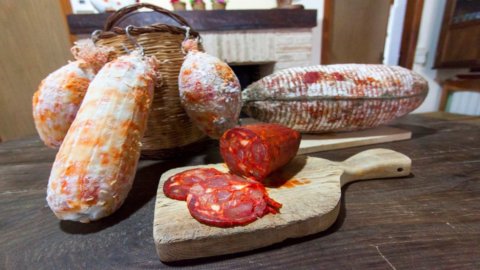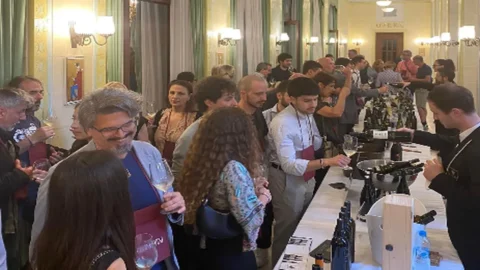Its origins are not very ancient: the first historical lexical attestation dates back to 1880, Gennaro Finamore spoke of it as a doctor, linguist and anthropologist in his "Vocabolario dell'uso Abruzzo" which was also very successful abroad. Little more than a century of life was enough to ensure that Ventricina Vastese, a humble traditional sausage of this area, became one of the most prized, most expensive cured meats – at the level of Capocollo di Martinafranca or Coppa di Parma – but above all the best in Italy as evidenced by the fact that in 2009, 2016 and 2017 Ventricina Vastese won the Italian Salami Championship organized by the 5 t academy (territory tradition typicality transparency traceability) a comparison that saw 50 products compete from 14 different regions. Comparison which among other things has also attested that Abruzzo is one of the regions with the greatest qualitative vocation for pork processing since Abruzzo out of six podiums for different processes has won three.
But what makes this sausage so special and what causes its high price?
Let's see it specifically Ventricina is a sausage typical of the area on the border between Abruzzo and Molise and of various municipalities in the Teramo area. The name derives from the fact that it was originally stuffed with the stomach of the pig. The main ingredients for eighty percent are noble lean cuts of pork such as ham, shoulder and bacon. The meats are then processed with salt, sweet peppers of the Corno di capra or paisanella variety and the chopped chilli pepper. In the artisanal variants, wild fennel seeds or pepper are sometimes added to obtain ventricine with a slightly different taste. The meat is rigorously cut with a knife tip to form irregular cubes of 3-4 cm. Furthermore, meat and condiments must come from territories explicitly authorized to use the brand. The slaughter requires that the thighs, loin and shoulders are first cleaned, boned and deprived of the toughest and most fibrous parts, those adhering to the bones and then dissected into small pieces of two or 3 cm which will rest for one night. Then they are seasoned with the expected ingredients. The pepper powder is obtained by drying the peppers for a couple of days, which usually come from the town of Altino, then choose the healthy ones, open them, clean them and pound them in a mortar. On average, 12 quintals of fresh peppers are needed to obtain a quintal of powder. bags
The seasoning of the Ventricina is carried out in rooms at a temperature not higher than 13° for not less than 100 days. After two months, however, it is covered with a lard coating to preserve its qualities and softness, but above all to protect the cured meat from insect infiltration and from sudden changes in temperature. Sometimes there are citrus notes that derive from the habit of washing the bladders for the stuffing in water flavored with oranges or lemons. The final taste is dominated by the spicy which however does not prevail and never hides the flavor of the meat and spices.
Obviously, as it was logical to imagine, this jewel of Italian food and wine has become part of the Slow Food presidia. “Rarely – reads the organization's website – does a territory have such a strong link with a product as the one that unites the upper Vasto area with Ventricina. Black or red pigs were once used to prepare it, today the most common and widespread white breeds in the area are purchased". The Di Lello family of the Fattorie del Tratturo - which are among the "constituents" of the Ventricina Academy whose animals are raised in the open air and fed with grains and legumes produced by the same farm - aims at black pigs of the Caserta breed, one of the last Italian natives. First of all - explains Luigi Di Lello - to preserve the tradition, using the Casertana breed (the one geographically closest to Abruzzo) then for its nutritional value, because these meats contain high percentages of unsaturated fats and an important part of omega3 and omega6 and for the structure of these pigs which present the characteristic of a distribution of the fat parts within the lean ones such as to make the Caserta black pig particularly interesting from the point of view of taste - olfactory. On average, a one-two kg shoulder is made which is placed in the hand-tied net and then hung to dry in a room with a fireplace that has been lit for at least seven, eight days. From a pig you get about three fairly large ventricine. “Once upon a time – recall the representatives of Slow Food – each family cut them only in important moments of rural life such as the harvest and the grape harvest”.
Ventricina is consumed after 7 8 months. Due to its flavour, it is not only consumed as a cured meat accompanied with bread in appetizers and snacks, in Abruzzo it also becomes an ingredient for ragù and to season pasta, absolutely fresh, which takes on an orange-red colour. The recipe requires first of all to very finely chop celery, garlic, onion and bay leaf. Then fry everything in extra virgin olive oil and let it go for a few minutes over medium heat. When the smells are withered, the ventricina is thrown into the pan and after two or three minutes the cherry tomatoes cut into pieces, leaving everything to cook for about twenty minutes.
It must be said that today the cured meat continues to be widespread in the Vasto area but there are only a few who follow the technique of the past, making it mature in the cooler areas of the middle and upper Vastese. The producers of the Presidium have therefore come together in an association and have drawn up a regulation which provides for the breeding of heavy pigs in the production area, GMO-free animal feed and a ban on the use of chemical preservatives.





